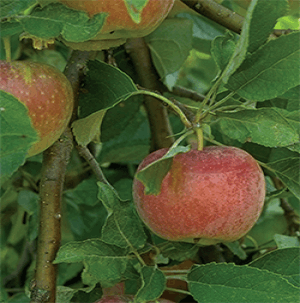By Richard Jauron
Soon, it will be time for apple trees to bloom and bear delicious fruit for all to enjoy. But not all apple trees are fruitful. Why are some trees more productive than others? There are several reasons worth exploring.

Iowa State University Extension and Outreach horticulturists can help answer queries regarding apple trees and their fruitful nature. To have additional questions answered, contact the ISU Hortline at 515-294-3108 or hortline@iastate.edu.
In regards to tree fruits, what is meant by the term self-unfruitful?
Pollination is the transfer of pollen from the anther to the stigma. After pollination and fertilization, fruit set occurs. There are two types of pollination. Self-pollination occurs when the pollen is transferred from the anther to the stigma on the same flower, from another flower on the same plant or from a flower on another plant of the same cultivar.
Self-pollinated plants are said to be self-fruitful. Many plants cannot produce fruit from their own pollen and are considered self-unfruitful. These plants require cross-pollination for fruit set. Cross-pollination is the transfer of pollen from one plant to the flower of a genetically different plant or cultivar.
Is it necessary to plant two different apple cultivars for fruit set?
Pollination requirements are an important factor when planting tree fruits in the home garden. Apples are regarded as self-unfruitful. Most apple cultivars will set a small crop with their own pollen. However, for maximum production, plant at least two different apple cultivars within 50 to 100 feet of one another to ensure cross-pollination and fruit set.
Will a crabapple pollinate a nearby apple tree?
A crabapple is a type of apple. The main difference between an apple and a crabapple is the size of the fruit. A crabapple is a tree that produces fruit that are less than 2 inches in diameter. An apple tree produces fruit that are larger than 2 inches in diameter. Most flowering crabapples will pollinate nearby apple trees.
Why isn’t my apple tree bearing fruit?
The lack of fruit is likely due to the absence of flowers, poor pollination or low temperatures during bloom.
The lack of flowers is often due to the age of the tree. After planting, most dwarf and semi-dwarf apple trees don’t flower and bear fruit for three to five years. Standard apple trees may not bear fruit for five to 10 years. Fruit trees have to grow and mature before they are capable of flowering and fruiting.
The growth of young apple trees may be slowed by unfavorable growing conditions (insufficient sunlight, heavy soils, etc.) and poor cultural practices. Poorly growing trees lack the vigor to form flower buds.
If the apple tree is flowering but not setting fruit, the lack of fruit may be due to poor pollination. Apples are self-unfruitful. Two different flowering apple trees (cultivars) need to be located within 50 to 100 feet of one another to ensure pollination and fruit set. Cold, rainy weather during flowering drastically reduces bee activity and can also reduce pollination and fruit set.
Fruit set also can be greatly reduced by freezing temperatures during bloom. A temperature of 28 degrees Fahrenheit (when the trees are in full bloom) will destroy 10 percent of the flowers. Ninety percent of the flowers will be destroyed when the temperature drops to 25 F.
Source: iastate.edu